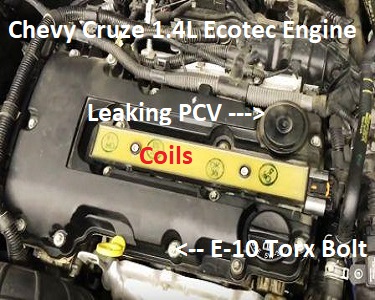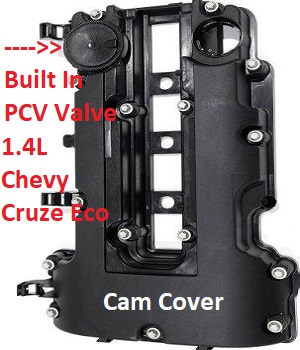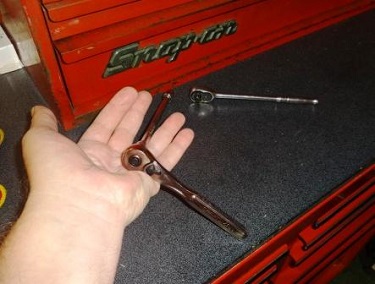Chevy Cruze Valve Cover
The Chevy Cruze valve cover is the latest plastic part to fail on my mom's 2011 Chevy Cruze. As a master technician I can only scratch my head as to why they built the PCV valve into the cam cover.
That's right, GM calls this part a cam cover even though most of us call it a valve cover. Before we get into the symptoms list, diagnostic procedure and the all-important repair tips, let's talk about what else we cover in this comprehensive article.
New Parts : Engine Camshaft, Valve Cover, Bolts and Gasket Compatible with 2011-2018 GM Chevy Cruze, Sonic and Trax Models.
In defense of the General Motors Corporation let me first say, they are not the only car company to use plastic parts in the engine compartment. With that said, the quality of this plastic remains questionable to me.
Two months after replacing the thermostat housing on my mom's car, it's now time to replace the thin plastic Chevy Cruze valve cover.
Since these parts are failing in such large numbers you can buy them on Amazon. I also think it's fair to say this common issue will eventually affect many 2008 through 2016 Chevy Cruze owners.
My family has a strong patriotic and long-running history with the GM brands. In fact, my mom says what's good for Chevy is good for America.
Unfortunately, they don't feel the same way in my opinion. We called for assistance with the plastic thermostat housing.
The vehicle at that point was only two months out of warranty, but way under by miles. The General declined any assistance.
We decided to call GM customer assistance just for fun with this latest Chevy Cruz valve cover problem. Now that the vehicle is even further out of warranty they declined assistance with a giggle.
After we talk about the technical details of this repair, we'll provide information about this conversation at the end.
 Chevy Cruze PCV and Valve Cover
Chevy Cruze PCV and Valve CoverDiagnosing the Leaking PCV Valve
My mom called and said that her Chevy Cruze Eco wasn't running right. She described it as a rough engine idle and severe lack of power.
Additional symptoms included sputtering, chugging and it felt like the engine was going to stall. In addition, we had a illuminated check engine light.
I thought this was good news, as I would be able to scan it and pull some trouble codes. However, the only code that set was a P0171.
This stands for system detected too lean on bank one. Although this doesn't exactly point you to a specific system, this code combined with the symptoms indicated a vacuum leak.
With the engine running I pop the hood and I could certainly hear leaking vacuum. I expected to find a disconnected or broken vacuum line.
However, what I did find boggled my mind a little bit. I could see and hear that the valve cover was leaking vacuum from a raised round portion. This is the built in PCV valve.
As you know, most PCV valves or positive crankcase ventilation systems use an inexpensive and highly reliable small valve.
These parts used to fit into a rubber grommet in the valve cover. We also replaced them as part of a tune up or maintenance service. If the part went bad it cost about six dollars and took about a minute to replace.
Unfortunately, they redesigned the system so the PCV valve became built into the valve cover itself. There's no fixing the issue.
You will have to replace the entire plastic cam cover. After I removed the cover I was able to see that the rubber diaphragm ruptured. When this happened, vacuum worked on the thin plastic cover until it cracked.
This allowed it to pull in outside air. Hence, the lean condition that set the trouble code. A lean condition is not good for the long term health of an engine.
A talk about this a little further in the repair tips section. However, this isn't something you want to let go, because a lean condition raises the combustion chamber temperatures and can damage other parts including the catalytic converter.
Chevy Cruze Valve Cover Repair Tips
 General Motors Camshaft Cover
General Motors Camshaft CoverReplacing a Chevy Cruze valve cover is within the wheelhouse of most do-it-yourself auto mechanics. There are plenty of videos on YouTube of people knocking this repair out quickly.
With that said, there are a few things to mention. One is that the new cover comes with new retaining screws. Therefore, when you loosen the bolts they continue to spin even though they are fully disengaged from the engine.
Also note that they stay with the cover. You don't actually pull each screw out. The other thing to mention about these retainers is they use a Torx E-10 sized bolt head. This isn’t a size or socket that every household keeps on hand.
As for the physical replacement procedure for the Chevy Cruze valve cover, it starts with removing the snap off cover that proudly displays the Ecotec emblem.
There are also a series of clips around the circumference of the valve cover that you need to disengage. These hold the wiring harnesses neatly in place.
The next step becomes to remove the Chevy Cruze ignition coils. This can be trouble and you need to be patient and here's why.
Depending on the age of the vehicle and the miles, the little rubber boots that run from the coil pack to the spark plug get stuck around the porcelain part of the spark plugs.
In fact it’s quite possible you'll tear these boots. Although it's not the end of the world, it adds to the repair time. You use to have to buy the entire coil assembly when this happened.
The aftermarket now makes individual boot kits. You can buy these individually for about eight dollars apiece or an entire kit for 25 bucks.
Before we get into the reassembly tips let me talk about the spark plugs. These extended life components last for about 60,000 miles according to the maintenance schedule in the owner's manual.
However, we just ran the engine in a lean condition for an unspecified period of time. As I mentioned above, lean conditions raise combustion chamber temperatures.
This can damage the electrode and the ground strap on the spark plug. Now’s a good time to replace them with a high quality iridium plug so you won't have to do this later on.
Procedure for Tightening Down the Valve Cover
 Inch Pounds Using a 1/4" Ratchet
Inch Pounds Using a 1/4" RatchetHere's an important point I want to make about replacing the Chevy Cruz valve cover. This part is made out of thin cheap plastic.
The factory torque specification for the Torx E-10 retainers comes in at 80 inch pounds. This is a fairly light torque specification.
In a lot of the YouTube videos, I see people running these retainers down with cordless screwdrivers or even worse, air ratchets and impact drivers.
Do yourself a favor and hand torque each one of these bolts with a quarter inch ratchet and a 6 inch extension. I have a trick to share with you on how to get by without an inch pound torque wrench.
If you take a look at the picture provided you’ll see what I'm talking about. You allow the head of the quarter inch ratchet to rest in the center of your palm.
Then you allow the extension to fit through the two middle fingers of your hand. This is somewhat like the Vulcan hand gesture for live long and prosper.
Holding the ratchet in this manner reduces the chance of you over tightening the valve cover and ignition coil bolts. Also note that it’s recommended to torque the inboard bolts first and work your way out to the edges.
With that said, I still recommend that you spend $30 on the inch pound torque wrench if you don't know what 80 inch pounds feel like. Some auto parts stores will also lend you an inch pound torque wrench.
It appears the failure of
the fuse box remains the cause of the latest electrical issue on the Chevy Cruze. We plan
on writing an article about this repair next. Until then, head back to the homepage to learn more about this website.
Author bio : Mark is a retired ASE certified master technician, Chevrolet Professional Service Council member and the founder of FixMyOldRide.com. Watch the video on the about Mark the mechanic page to see his credentials. Mark hand writes all of the articles on FixMyOldRide.com unless indicated otherwise.